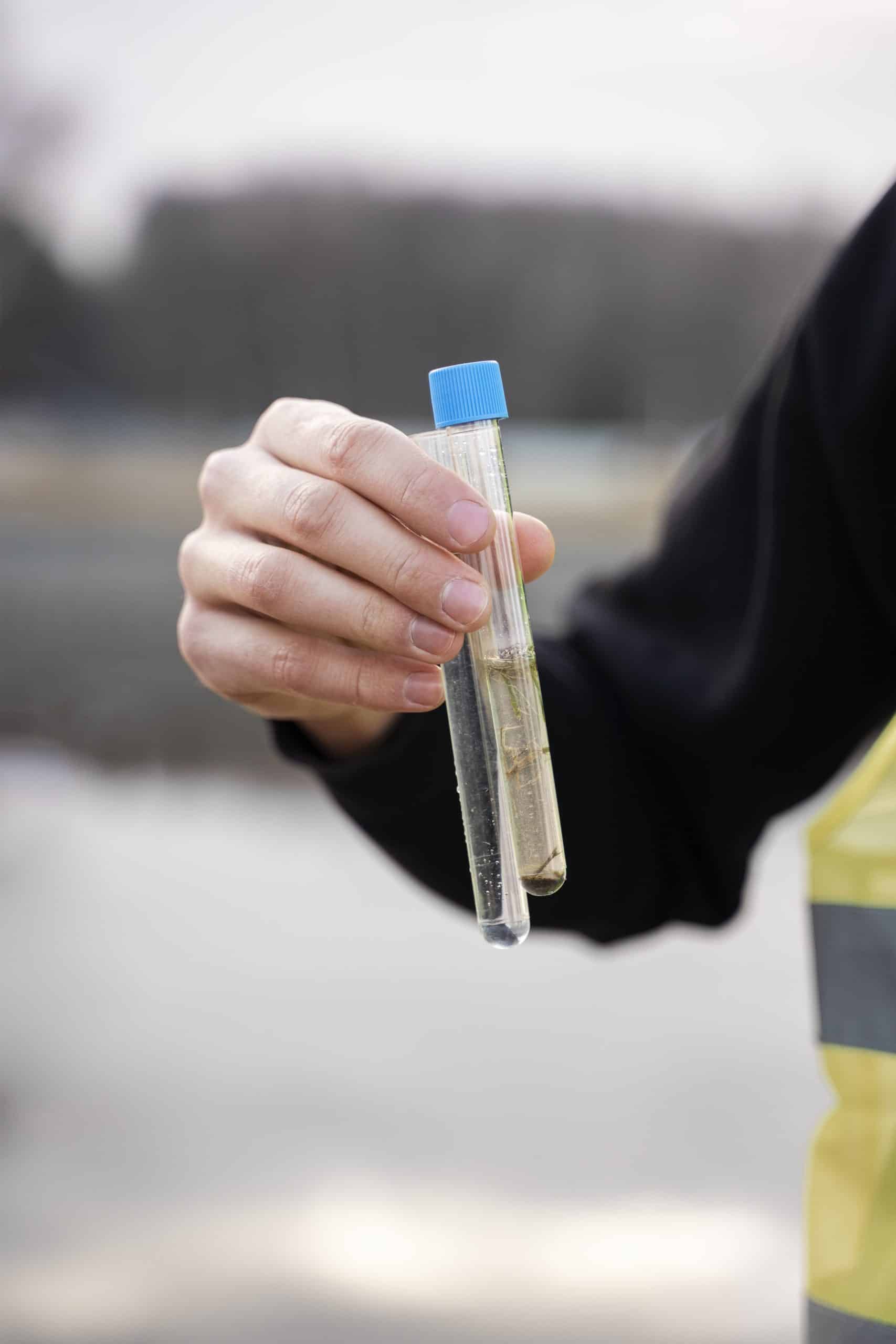Water analysis parameters
When you have your water analyzed in a laboratory, different parameters are studied. These parameters allow you to understand the composition of your water.
The certificate of analysis you receive from the laboratory will tell you, for example, if your water is contaminated by bacteria or if it contains minerals or metals in excessive concentrations. For each parameter, the certificate shows a maximum not to be exceeded, as well as your specific result.
There are two main categories of parameters analyzed in the laboratory:
- Microbiological parameters
- Physico-chemical parameters

Microbiological parameters
Microbiological parameters are also called bacteriological parameters. They consist of checking for bacteria and other microbes in the water. Some bacteria and germs can cause immediate health consequences such as gastroenteritis.
In other words, the microbiological parameters allow us to know if your water is drinkable.
The main microbiological parameters analyzed in the laboratory are :
- The E. coli bacterium, which is part of the fecal coliforms
- Fecal enterococci
- Total coliforms
- Atypical colonies
Physico-chemical parameters
Physical and chemical parameters can affect the taste, odor and overall appearance of your water. In our jargon, this is called the “physicochemical aesthetic parameters”. When certain parameters exceed the recommended maximum, water can also leave marks on clothing, dishes or bathroom equipment, or damage plumbing equipment.
The main physico-chemical aesthetic parameters analyzed are:
- Alkalinity
- Chlorides
- Conductivity
- True color
- Total hardness
- Iron
- Manganese
- pH
- Sulfur
- Tannins and lignins
- Turbidity
- Ultraviolet: absorbance and transmission
Some of these physico-chemical parameters can have consequences on your health. They are then called “physico-chemical health parameters”.
The consequences can be immediate, such as causing gastroenteritis or having a laxative effect.
But for many of these health parameters, consequences can occur when a person is exposed for several years to water with too high a concentration of a contaminant.
The main physico-chemical health parameters analyzed are :
- Nitrites-nitrates
- Sulphates
Other physico-chemical health parameters such as arsenic and barium can be analyzed. In fact, it is only with the help of a water analysis that their presence can be detected, as they are tasteless, odorless, colorless and leave no traces. However, they are rarely found in the Lanaudière and Laurentian regions.
Microbiological parameters
In a laboratory analysis, E. coli (Escherichia coli) is the main bacterium looked for among the fecal coliforms. Fecal coliforms are present in the digestive system of humans and mammals. They grow at 37 degrees Celsius.
Their presence in the water indicates recent fecal pollution near the water source. For example, a leaking septic system or the spreading of manure or slurry around your well.
The presence of fecal enterococci in the water confirms that there is fecal pollution in the vicinity of the well even though there are no fecal coliforms. In fact, enterococci are another type of fecal bacteria that live in the digestive system of humans and mammals.
Fecal enterococci survive for a long time in soil and water. This means that the pollution may have come from further away, meaning that the bacteria may have traveled a greater distance before contaminating your water source.
The presence of total coliforms does not indicate pollution of fecal origin. Generally, these coliforms come from the decomposition of plants.
These are groups of bacteria that are not normally found in well water. However, when they develop during water testing, they may indicate a water contamination problem.
In addition, when they are found in too large quantities in the water during analysis, they will prevent an accurate count of total coliforms. They will therefore affect the result of this other parameter.
Physicochemical and aesthetic parameters
Maximum recommended : less than 10 mg per liter of water
Nitrates-nitrites are present almost everywhere in nature. They come from the oxidation of nitrogen in the natural environment.
The concentration of nitrate-nitrite in drinking water must not exceed 10 mg/L. Indeed, above this concentration, they can create blood oxygenation problems and serious respiratory problems in young babies and pregnant women.
Maximum recommended : less than 500 mg per liter of water
Sulfates come from gypsum rocks and from the oxidation of sulfides found in rocks such as pyrites. The most frequently encountered sulfates are sodium sulfate, ammonium sulfate and magnesium sulfate. In Quebec, the maximum allowable sulfate concentration is 500 mg/L.
However, a concentration of 250 mg/L can already cause gastrointestinal problems in children. A concentration of 300 mg/L can be laxative in adults. In Europe, water is considered undrinkable if the sulfate concentration exceeds 250 mg/L.
Physicochemical and aesthetic parameters
Maximum recommended : 30 to 500 mg per liter of water
Alkalinity is the carbonate, bicarbonate and hydroxide content of water. There is no recommended maximum for alkalinity, but it is considered “good” from 100 to 200 mg/L and “acceptable” from 30 to 500 mg/L.
Alkalinity is the main factor to control in order to reduce the aggressiveness of the water or its scaling power.
Aggressive water tends to corrode the metal of pipes and plumbing fixtures. Corroded copper plumbing can leave blue streaks in the bath, sinks or toilets.
Conversely, scaling water tends to allow salts to settle in the pipes and fittings, thus reducing their useful diameter.
Maximum recommended : less than 250 mg per liter of water
Chlorides are present in almost all waters.
The source of the chlorides may be due to percolation of water through sedimentary rocks, saltwater intrusion into groundwater, and the spreading of sodium and calcium chloride on roads in winter.
Concentrations are highly variable, ranging from a few dozen mg/L to over a thousand mg/L.
Above 250 mg/L, the water may taste salty.
At high concentrations, chlorides are also corrosive agents.
Maximum recommended : less than 1650 ms per centimeter
Conductivity is the ability of water to conduct electricity. It is directly related to the concentration of impurities in the water. Conductivity measurement is influenced by pH and temperature.
Maximum recommended : less than 15 VCUs
In general, the color can be of mineral or organic origin.
The main minerals that can color water are iron and manganese. Iron is responsible for the reddish hue while manganese is responsible for the blackish hue.
As for the organic substances at the origin of the coloring, they are numerous. To name a few, there are algae, plant decomposition, tannins and lignins.
True color is the color of the water after it has been filtered. This parameter is very important as it indicates the true origin of the color present in the water. In fact, once filtered, the water should not have any iron or turbidity. The origin of the color should therefore be organic, and more particularly due to the presence of tannins.
Maximum recommended: less than 120 mg or 120 ppm per liter of water (Both measurements are equivalent.)
Hardness is the measure of metals and minerals dissolved in water. More precisely, water is said to be hard when it contains a lot of calcium and magnesium.
Natural water, rich in carbon dioxide and oxygen, can easily dissolve these naturally occurring metals and minerals. It can thus acquire a hardness of several thousand mg/L.
In some cases, hardness can become a problem. For example, too much hardness does not dissolve the soap well. It then becomes difficult to rinse. Hard water can also stain dishes or leave lime deposits in hot water tanks and kettles.
Conversely, if the water does not contain enough hardness, it becomes aggressive and attacks the pipes and other accessories through corrosion.
Degree of water hardness
| Type of water |
Degree of hardness milligrams per liter (mg/L) or parts per million (ppm) |
| Soft | 0-60 |
| Moderately Soft | 60-120 |
| Hard | 120-180 |
| Really Hard | 180 and more |
Maximum recommended : 0.3 mg per liter of water
Iron is often present in water, and in varying amounts depending on the region and the source of the water. Iron is not a toxic substance, but above the recommended maximum, it is responsible for stains left on clothing and plumbing fixtures.
Maximum recommended :
- For aesthetics : 0.02 mg per liter of water
- For health : 0.12 mg per liter of water
Manganese is often present in water in varying amounts depending on the region and the source of the water. The maximum recommended concentration is different for aesthetics and for health. In fact, with as little as 0.02 mg/L of water, manganese gives an unpleasant color and taste to the water. In higher concentrations, it can also have harmful effects on health, especially for babies.
Maximum recommended : from 6.5 to 8.5
The hydrogen potential, called pH, is a measure of the activity of hydrogen in water. The pH scale varies from 0 to 14 as follows:
| 0 | 1 | 2 | 3 | 4 | 5 | 6 | 7 | 8 | 9 | 10 | 11 | 12 | 13 | 14 | ||
| Acidic pH | Acceptable pH | Alkaline pH, also called basic | ||||||||||||||
Water type according to the pH scale
| Type of water | pH scale |
| Acidic water | from 0 to 6,4 |
| Slightly acidic water | from 6,5 to 6,9 |
| Neutral water | pH 7 -7,1 |
| Slightly alkaline water (basic) | from 7,2 to 8,3 |
| Alkaline (basic) water | from 8,4 to 14 |
On this scale, one unit corresponds to a difference in concentration multiplied by ten. Thus a water of pH 5 is ten times more acidic than a water of pH 6.
Even if the pH value is neutral, the water can be aggressive if the hardness and alkalinity are low.
Maximum recommended : 0.05 mg per liter of water
Hydrogen sulfide is one of the natural forms of sulfur.
It gives the water a rotten egg smell and a bad taste. It can also corrode pipes and blacken silver-plated dishes and utensils. In fact, in hot water, sulfur leaves a gray deposit that looks like soot.
However, sulphur is not harmful to health.
Maximum recommended : about 0.5 mg per liter of water
Tannins and lignins come from plants and wood.
They can be found in water as a result of normal decomposition of plant material or as a result of releases of plant material into the environment from industries such as pulp and paper mills.
The presence of tannins in the water influences the results for the “true color” parameter.
Maximum recommended : less than 5 UTN
Turbidity is caused by fine particles that remain suspended in the water and make it cloudy. These particles come from silt, clay and other organic and inorganic matter in the water. In fact, turbidity is the opposite of clarity.
Certain weather conditions can change the turbidity of your water such as heat waves in the summer, torrential rains and lake overturns in the fall and spring – the natural circulation of water that occurs during these seasons.
Minimum recommended : 85% transmission
Water can be analyzed using ultraviolet (UV) light. These verify:
- The proportion of UV rays that are absorbed by the water.
This is called the UV absorbance. - The proportion of UV rays that pass through the water.
This is called UV transmission.
In fact, the less UV rays are absorbed by water, the more they pass through it. The results of these measurements therefore provide good clues for predicting the effectiveness of UV disinfection.
